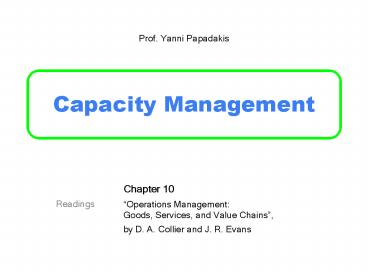Capacity Management - PowerPoint PPT Presentation
1 / 24
Title:
Capacity Management
Description:
I'd rent the refrigerated rail cars for a few more days until we can get you in ... Cool-It Storage will pay for rail car or public storage. 4. Understanding Capacity ... – PowerPoint PPT presentation
Number of Views:526
Avg rating:3.0/5.0
Title: Capacity Management
1
Capacity Management
- Chapter 10
- Operations Management Goods, Services, and
Value Chains, by D. A. Collier and J. R. Evans
2
Matching Supply to Demand(easier said than done)
- McDonalds restaurants in Britain apologized to
millions of unhappy customers for running out of
Big Macs during a weekend 2-for-1 promotion to
celebrate its 25th anniversary in Britain. - The demand generated by the promotion far
exceeded forecasts. The promotion caused many of
the nations 922 outlets to turn away long lines
of customers.
3
Matching Supply to Demand(easier said than done)
- What do you mean, you have run out of
refrigera-ted storage room? Ive got two
refrigerated rail-road cars of pears heading to
your facility - Sir, we got a surge in demand for our
refrigerated storage and we are full. Im really
sorry but we cannot kick out our existing
customers products. - So what am I suppose to do with millions of fresh
pears headed to the northeast coast - Id rent the refrigerated rail cars for a few
more days until we can get you in our
refrigerated warehouse. Cool-It Storage will pay
for rail car or public storage.
4
Understanding Capacity
- Capacity is the capability of a manufa-cturing or
service resource such as a facility, process,
workstation, or piece of equipment to accomplish
its purpose over a specified time period. - Measured as
- Maximum rate of output per unit of time
- Units of resource available
5
Short Term FlexibilityAiming Well for Long Term
6
Short Term Flexibility
Units/period
7
Choosing Right TargetFor Long Term
Units/period
8
Capacity Measurement
- Theoretical (Design) Capacity is the maximum
output per unit of time the process can achieve
for a short period of time under ideal operating
conditions. - Effective Capacity is the actual output per unit
of time that the organization can reasonably be
expected to sustain in the long run under normal
operating conditions. - Safety Capacity (Capacity Cushion) is defined as
an amount of capacity reserved for unanticipated
events such as demand surges, materials
shortages, and equipment breakdowns.
9
Demand and Capacity Matching
10
Capacity MeasurementWhen Batching
- Setup time
- part.130min, part.260min
- Processing time
- part.120min/part, part.230min/part
- Daily Production Requirement
- part.115 , part.23
- Schedule without batching
- AM part.1 (10), NOON part.2 (3), PM part.1 (5)
- Setup time 306030 120 min, Processing
30090 390 - Schedule with batching
- AM - NOON part.1 (15), PM part.2 (3)
- Setup time 30 60 90 min , Processing
30090 390
11
Capacity Allocation
- What changes if an assistant is hired?
12
Long Term Capacity Strategies
13
Capacity Expansion Options
14
Capacity Decision Analysis
15
Sequential Capacity Decisions
16
Roll Back Decision Tree
17
New Product Introduction
18
Airline Discount-Fare Request
.75x560.25x0 420
19
Short-Term Capacity Management
- Supply Side
- Add/share equipment
- Sell (subcontract) unused capacity
- Change labor capacity
- Part-timers
- Vacations
- Overtime
- Reallocate multifunctional workers
- Shift work to slack periods
20
Short-Term Capacity Management
- Demand Side
- Change Price
- Coupons
- Specials
- Focus customer attention
- Advertising / Promotion
- Change Customer Benefit Package
- Reservations / Backlogs
21
Revenue Management Systems
- Manage demand using continuously changing prices
so that capacity utilization is optimized for
perishable resources - Hotel room generates value only if a customer
uses it. High prices may lead to zero revenue. - However, if room price is set too low, then low
profitability customers get service and high
profitability customers do not. - Key is to forecast demand well and offer low
prices in slow periods but high prices during
strong demand.
22
Overbooking
- Booking more units (e.g. hotel rooms) than
capacity to compensate for no-shows - If everybody shows up, then provide incentives so
that some customers use alternatives - Note that no-shows result even when there are
penalties (no refund of ticket). - Could make company look greedy - cheap.
- May lead more customers to fixed-price
competitors
23
Theory of Constraints
- All real-world systems have at least one
constraint otherwise they would be capable of
infinite throughput. - If people are instructed to leave the auditorium,
the rate at which people can walk through the
door is the same, regardless of the number of
people in the auditorium. The particulars of the
doorway set the rate (/time) at which people can
exit.
24
TOC Principles
- Identify the system's constraint(s).
- Decide how to exploit the constraint(s).
- Subordinate everything else to the above
decision. - Elevate the constraint.
- If, in any of the above steps, the constraint has
been broken, go back to Step 1.































